Modern tech startups are striving to break down the boundaries between the virtual and real world with blockchain technology that is changing our world. Distributed technologies in mobile applications allow today to integrate cryptocurrency payments along with other internet payment options. You can build a bitcoin wallet to suit the business needs or integrate it for use as a payment method.
In this article, we are going to discuss cryptocurrency wallets, their types, benefits, main features, and challenges.
Table of Contents
- 1 What is a cryptocurrency wallet?
- 2 What are the types of bitcoin wallets?
- 3 Advantages of crypto wallet apps
- 4 How you may use bitcoin wallets?
- 5 How to build a bitcoin wallet?
- 6 Main features of crypto wallet applications
- 7 Recommended technologies for cryptocurrency wallet development
- 8 Download our detailed estimate: How to Develop a Cryptocurrency Wallet
- 9 How much does it cost to build your bitcoin wallet?
- 10 Challenges of crypto wallet development
- 11 Our expertise
- 12 Conclusion
What is a cryptocurrency wallet?
Cryptocurrency can’t be used without a special software program. This kind of program is called a digital wallet. It’s associated with the blockchain and helps perform operations.
According to Statista, cryptocurrency wallets reached over 70 million wallet customers at the end of March 2021.

Most cryptocurrency wallets support Bitcoin and Ether, the two widespread digital currencies. However, with the growth in the number of altcoins, many desktop wallets support various cryptocurrencies nowadays.
The bitcoin wallet transaction is based on asymmetric key cryptography, which uses two types of keys — a public key and a private key.
When someone sends bitcoins to one wallet address from their own, they transfer ownership of the coins to the recipient’s wallet address. The transaction is saved as a transaction record on the bitcoin blockchain and balance changes will take place in the respective bitcoin wallets.
What are the types of bitcoin wallets?
Bitcoin wallets can be divided into two categories: hot and cold.
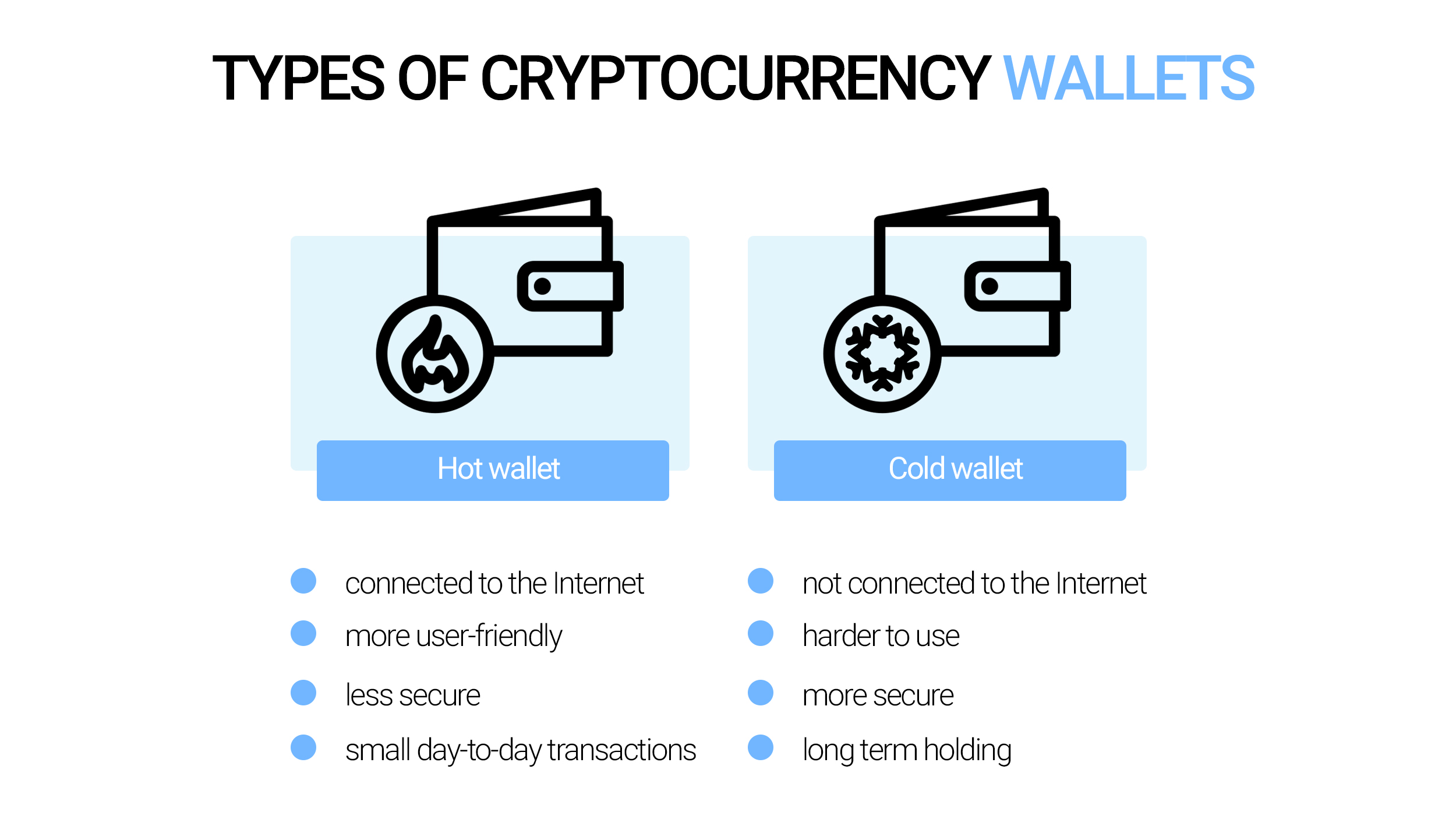
☑️Cold storage wallets are safer as they are stored physically. Thus, hackers don’t have any access to them.
Now, let’s move on to the four different types of bitcoin wallets:
Desktop
Desktop wallets are intended for a desktop computer and give people complete control over the wallet. Desktop wallets function as an address where a user can send and receive bitcoins. They also allow the customer to store the private key. Several notable desktop wallets include Bitcoin Core, MultiBit, Armory, Hive OS X, and Electrum.
Mobile
Mobile wallets have the same features as desktop wallets. But they make it easy to pay at physical stores by scanning QR codes with touch-to-pay and Near Field Communication (NFC). Bitcoin Wallet, Hive Android, and Mycelium Bitcoin Wallet are examples of mobile wallets. Bitcoin wallets are generally compatible with the iOS or Android system. There is a considerable amount of malware posing as bitcoin wallets, so it is a good idea to research your options before deciding the one to use.
Web
Web wallets make it easy to access bitcoins from anywhere, from any browser or mobile device. Choosing your web wallet should be done carefully as it stores your private keys online. Coinbase and Blockchain are popular web wallet providers.
Hardware
Now, hardware wallets are the most secure type as they store bitcoins on physical hardware, which is usually connected to a computer via a USB port. They are virtually immune to virus attacks and there have been several reported cases of bitcoin theft.
How to Build an NFT Marketplace: A Comprehensive and Step-by Step-Guide
Advantages of crypto wallet apps
Crypto wallets allow people to manage and process any digital cryptocurrencies. Below we listed the reasons why bitcoin wallets are so profitable and comfortable:
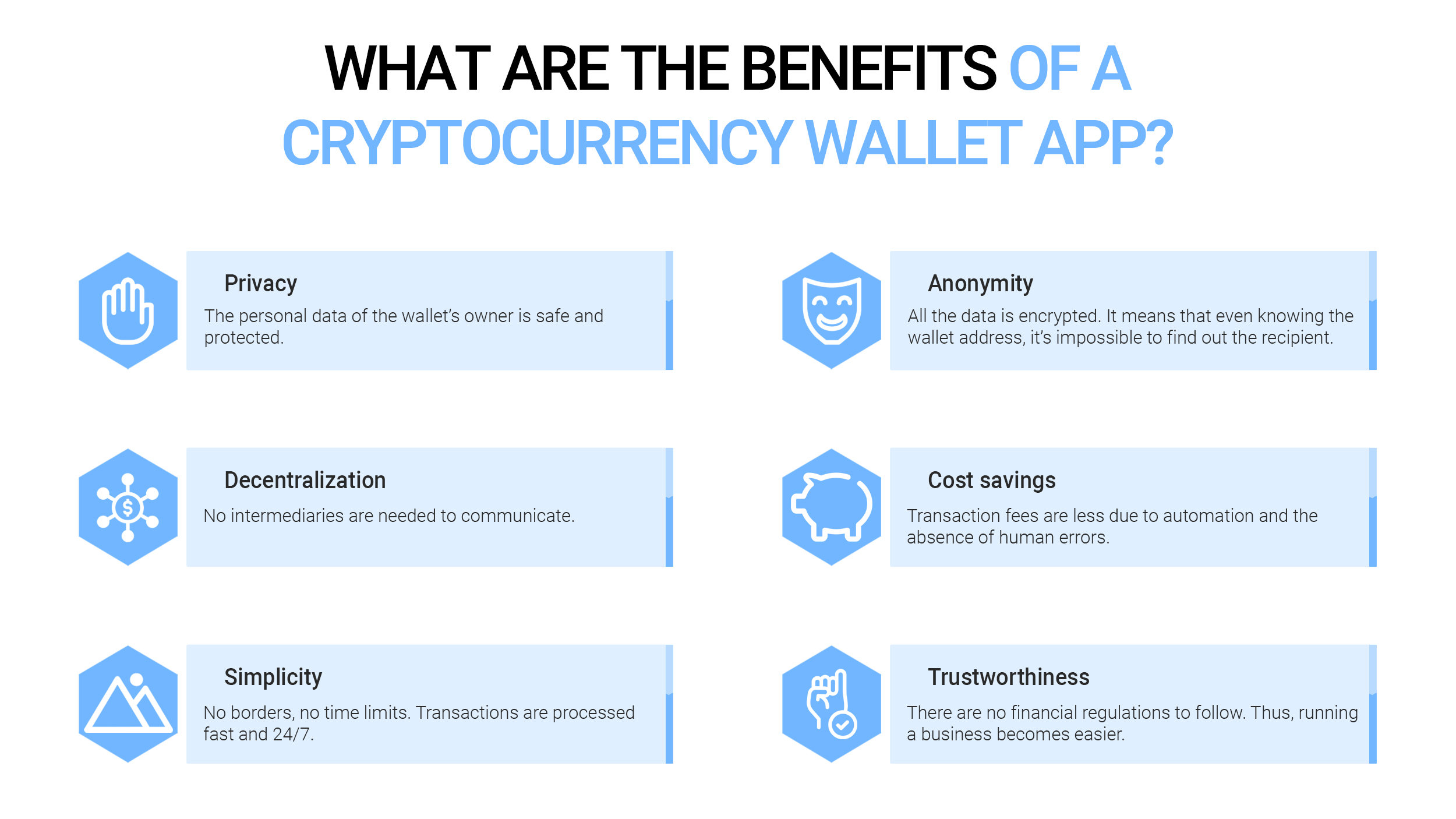
- Privacy
The personal data of the wallet’s owner is safe and protected.
- Decentralization
No intermediaries are needed to communicate.
- Simplicity
No borders, no time limits. Transactions are processed fast and 24/7. Moreover, processes are rather simple. That’s why it’s a perfect option for cross-border trades.
- Anonymity
All the data is encrypted. It means that even knowing the wallet address, it’s impossible to find out the recipient.
- Cost savings
Transaction fees are less due to automation and the absence of human errors.
- Trustworthiness
There are no financial regulations to follow. Thus, running a business becomes easier.
- Transparency
Crypto wallet apps offer customers the highest level of financial transparency.
How you may use bitcoin wallets?
Below you can read about the main ways of using the Bitcoin wallet app. Let’s take a closer look:

Instead of using a plastic card for purchases, you can pay using the wallet application installed on your devices — smartphone or tablet. By using cryptocurrency when purchasing, you can simply select the bitcoin currency at checkout to complete your purchase. The payment system converts the currency into bitcoins and completes the purchase.
✓Payment of wages
Many people want to receive their salary in bitcoin. For them, it is a more convenient way to receive wages compared to a regular bank transfer. One way to accept a Bitcoin salary without any problem is to create a wallet address so that the employer can pay the monthly Bitcoin amount.
✓International transfers
A bitcoin wallet can be used for international transfers. This will make it easy to send money abroad in minutes with no additional fees. Bitcoin cryptocurrency is also an easy way to send money abroad without intermediaries. There are no particular restrictions on the minimum or maximum amount you can send.
How to build a bitcoin wallet?
Now it’s time to move on to the main stages of Bitcoin wallet development. The first thing you should know is that there are two options: you can use ready-made templates and a set of tools to create an application, customizing it to your needs, or develop your wallet that will ideally fit your requirements from scratch.
Creating a custom wallet application
There are few open-source standard libraries available on the market. They can be used as a basis for your future app. The standard library provides the necessary functionality, configures the wallet for blockchain, and executes financial transactions.
Stages of developing a cryptocurrency wallet application
1. Installation
Download the API from the respective site
2. Create
Click the corresponding button in the menu to create a new wallet.
3. Setting
Provide your wallet name and set up permissions for outgoing and incoming transactions.
4. Integration
Select the third-party programs that you need (for example, to check the balance or create an address) and integrate them with your wallet.
Developing Bitcoin wallet apps from scratch
The other variant is to create your project from scratch. Bitcoin code is open source and free. So, it’s not a problem to find all the standards and create an independent application that fits personal preferences and business needs. This kind of development is more difficult and expensive, as it requires more time, effort, and knowledge. However, a custom application is always more valuable as it is perfect for all needs.
Stages of developing a custom wallet for cryptocurrency
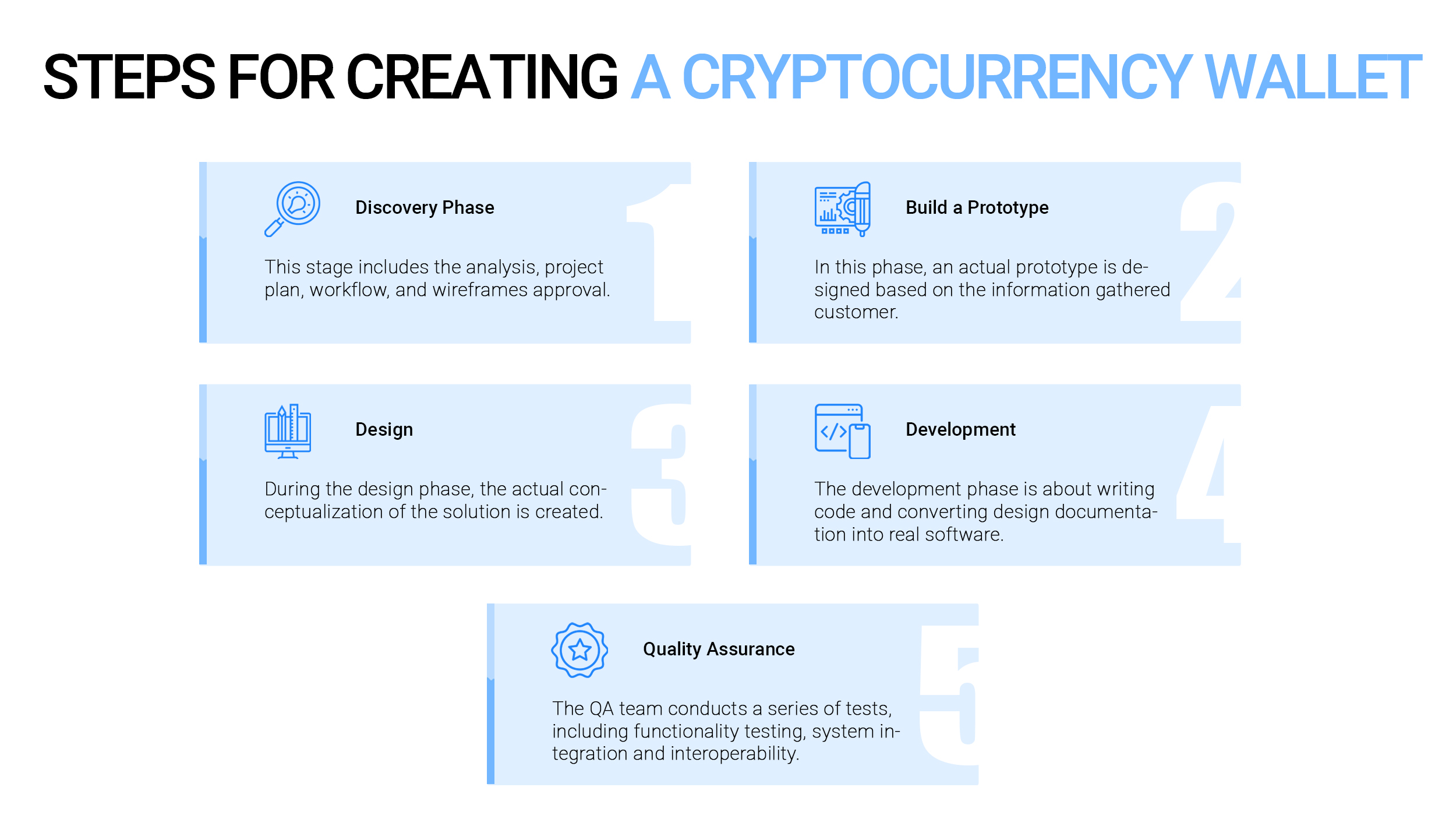
This stage includes the analysis, project plan, workflow, and wireframes approval. It helps to define business goals, analyze and prepare a plan for further development and find optimal technologies.
2. Build a Prototype
In this phase, an actual prototype is designed based on the information gathered customer. It is a small working model of the required system.
3. Design
During the design phase, the actual conceptualization of the solution is created, that is, detailed software architecture is created that meets the specific requirements of the project.
4. Development
The development phase is about writing code and converting design documentation into real software during the software development process.
5. Quality Assurance
The QA team conducts a series of tests, including functionality testing, system integration and interoperability, and user acceptance testing to ensure that the code is clean and that the solution’s business goals are met.
Main features of crypto wallet applications
Authorization
In this function, users can register or fill out a form with their keys to access their bitcoin wallet. One way to make sure your app is tamper-proof right from this first adaptation step is to add Google two-factor authentication. By adding 2-Step Verification to an application, companies can add an extra layer of security that conventional non-cryptographic applications typically avoid.
Conversion rate

List of addresses
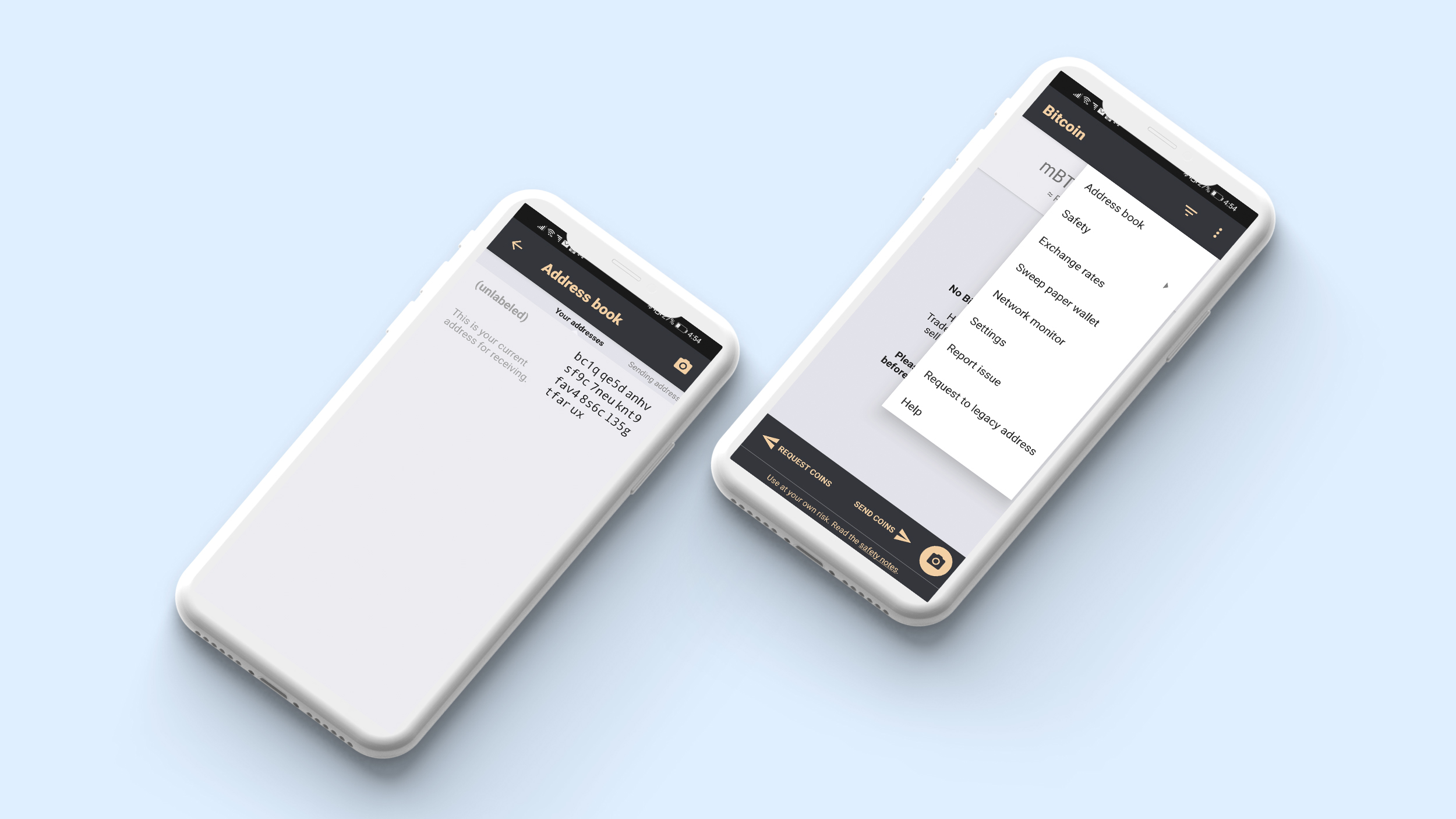
Notifications
Using the push notification function, the administrator will be able to notify the users of the cryptocurrency application about the price of their digital currency, the success, and failure of the transaction, adding an address, etc. Thanks to this function, users will be able to stay connected. receive information about all actions in your account in real-time.
Paper Wallet Import

Transaction
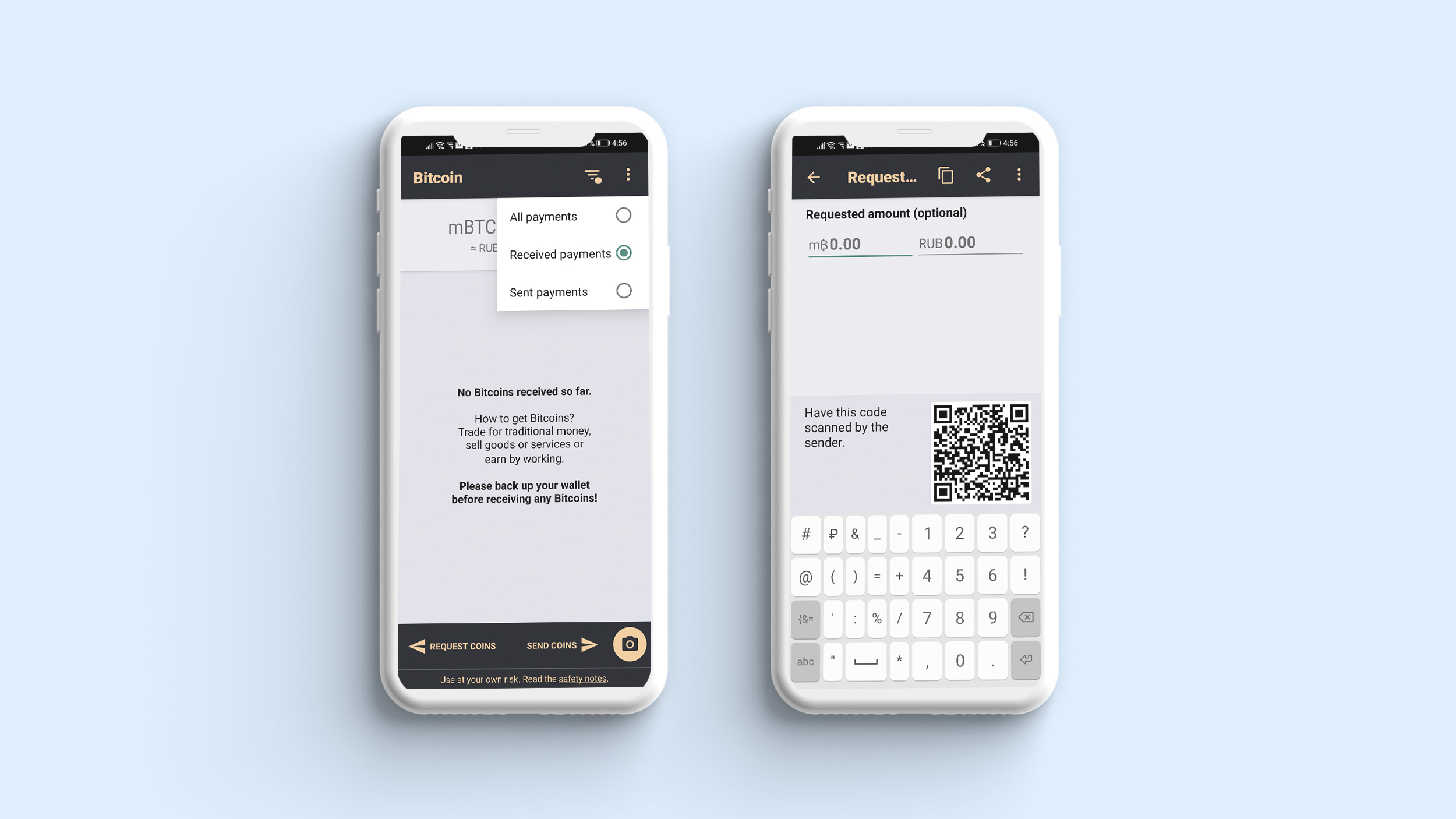
The whole point of Blockchain is to change the future of transactions. The most important part of a cryptocurrency wallet application is the transaction function. Thanks to this, users will be able to send and receive digital currencies in the cryptocurrency application. This section of the application is 100% tamper-proof and fast.
Security
A common but equally important part of a cryptocurrency wallet app is the security feature it comes with. Based on Blockchain, a technology known to revolutionize mobile app security, you must provide your users with the ability to change their PIN, password, or any other personal information they wish to change in the app.
QR code scanner
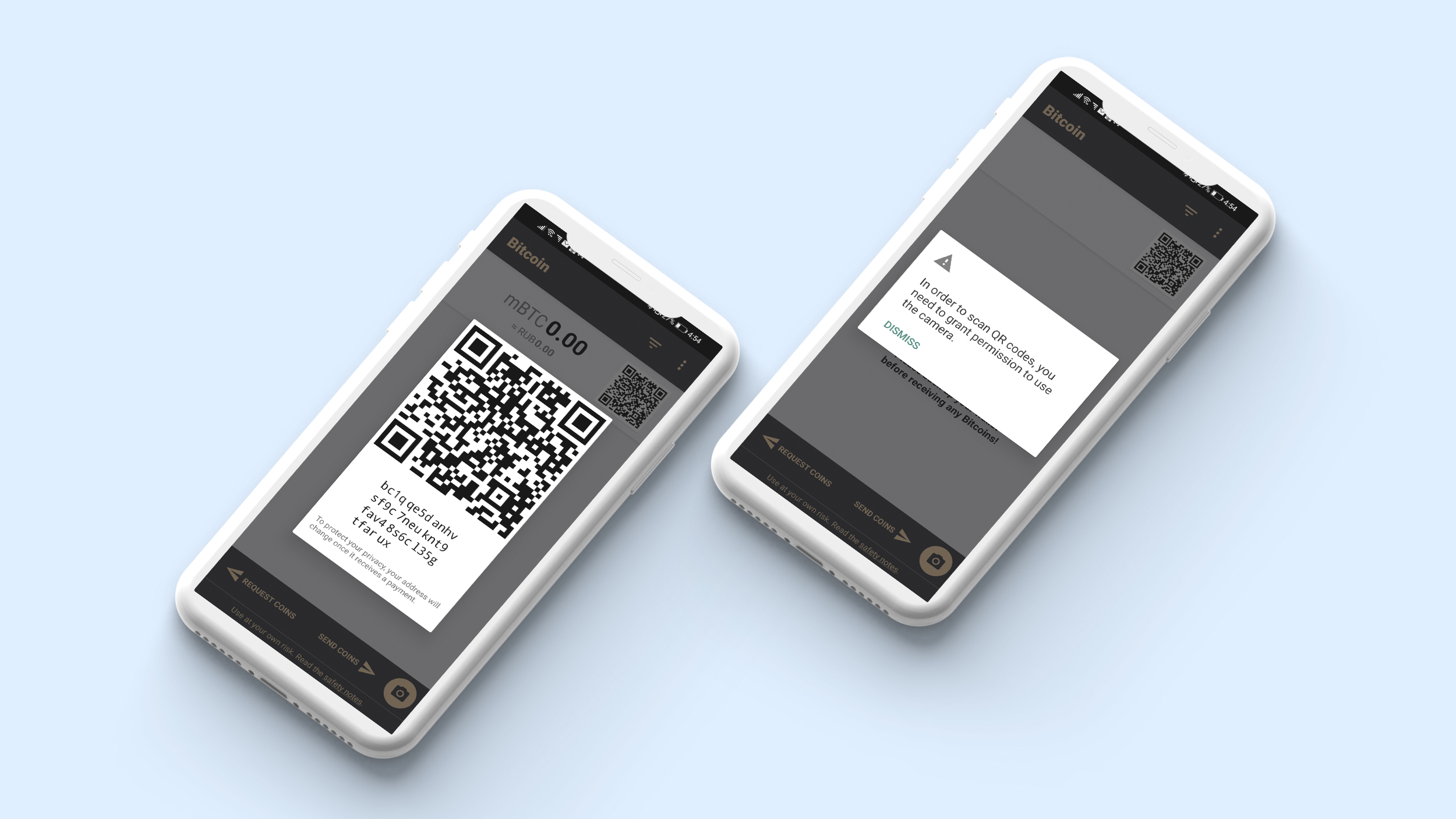
NFC support
NFC support works on an asset transfer mechanism based on the proximity of the device. This is usually done when the sender clicks on the NFC tag, obtains the recipient’s wallet address and processes the transaction.
12-word mnemonic phrase
It is one of the main features that make it easy to restore the wallet when the wallet is deleted or moved to another device. The mnemonic passphrase is usually attached to the private keys so that they can be matched with security features.
Recommended technologies for cryptocurrency wallet development
Now that we’ve talked about the features that need to be integrated when building a Bitcoin wallet, it’s time to talk about the technical side of building a Bitcoin wallet app.
If you are building a web bitcoin wallet app, you should use Angular JS 10.0 and above to build the frontend along with HTML5 and CSS3. Use Node JS to create the back end, and you can use AWS to set up the server.
We highly recommend our clients develop cross-platform solutions. This shouldn’t come as a surprise – using this approach allows companies to save time, money, and effort. Thus, you will need React Native to create a frontend and API service using Node JS for the backend.
Moreover, for signing and verifying data with Ethereum keys we should create a collection of functions. Typescript fits the best for it.
However, if building an app from scratch isn’t what you want to do, you can easily use the public libraries available on the web to build your app.
These libraries will implement the standard functionality of your application and synchronize it with the blockchain. Some of the great examples of public libraries are Chain-Java and BitcoinJ.
How much does it cost to build your bitcoin wallet?
Pointing out all the features, technology stack, and hours of resources that would be required to develop rich Bitcoin applications, we have drawn up a chart of the cost estimates you will have to pay to develop applications such as a Bitcoin wallet.
| Scope | Approx time, hours |
| 1. Project Start | |
| Initial backlog preparation | 4 |
| Project Schedule Preparation | 4 |
| Staging environment setup | 6 |
| 2. Development Section (Back-end) | |
| Setup AWS | 17 |
| Setup DB | 9 |
| Upload to AWS | 8 |
| Sign In | 9 |
| Sign Up | 9 |
| Profile info | 18 |
| Account balance | 8 |
| Contacts | 32 |
| Transaction history | 25 |
| Payment system | 12 |
| Cash In | 18 |
| Cash-out | 18 |
| 3. Development Section (Front-end) | |
| Sign In page | 8 |
| Sign Up page | 41 |
| Profile page | 24 |
| Account balance | 8 |
| Side menu | 10 |
| Contacts | 33 |
| Transaction history | 16 |
| Cash In page – QR code or keys code | 40 |
| Cash-out page – QR code or keys code | 24 |
| Payment P2P to other contacts or Bill payment | 62 |
| Localization | 32 |
| 4. Stabilization and Delivery | |
| Release Android build | 4 |
| Deploy to production (server app) | 6 |
| Release iOS build | 24 |
| 5. Project management | |
| Backlog elaboration and maintenance | 24 |
| Planning meetings, review meetings | 12 |
| Project Management and communication | 28 |
| Quality Assurance, hours: | 129 |
| Total Development, hours: | 515 |
| Project Management, hours: | 78 |
| Total: | 722 |
Thus, the cost of developing a blockchain app depends on the complexity of the project and the list of features you want to add to your app. To get the detailed estimation contact us via email: andrew.gromenko@code-care.pro.
Challenges of crypto wallet development
The crypto wallet development is a complicated task. So, you should be ready for the pitfalls you may face. Here is the list of the main of them.
☑️Regulation
The legal status of cryptocurrencies and blockchain technology varies significantly from country to country.
☑️Initial costs
Blockchain promises long-term cost savings, but its implementation requires a high initial price.
☑️Integration with legacy systems
To migrate to a blockchain-based system, a company must either completely redesign its existing system or integrate it with a blockchain solution; both processes can take a lot of time, money, and experience
☑️Power consumption
Blockchain networks require a significant amount of computing power to function; this can be a limiting factor for many companies
☑️Security and privacy
Since the network is publicly available, this poses some challenges for governments and corporations looking to protect their sensitive data.
☑️Public opinion
Society is not ready for mass blockchains as most people are unaware of the technology and its potential benefits.
Our expertise
The Code&Care team has wide experience in cryptocurrency wallet development. The most prominent project is Bitfintex. It is one of the largest cryptocurrency exchange/trading platforms.
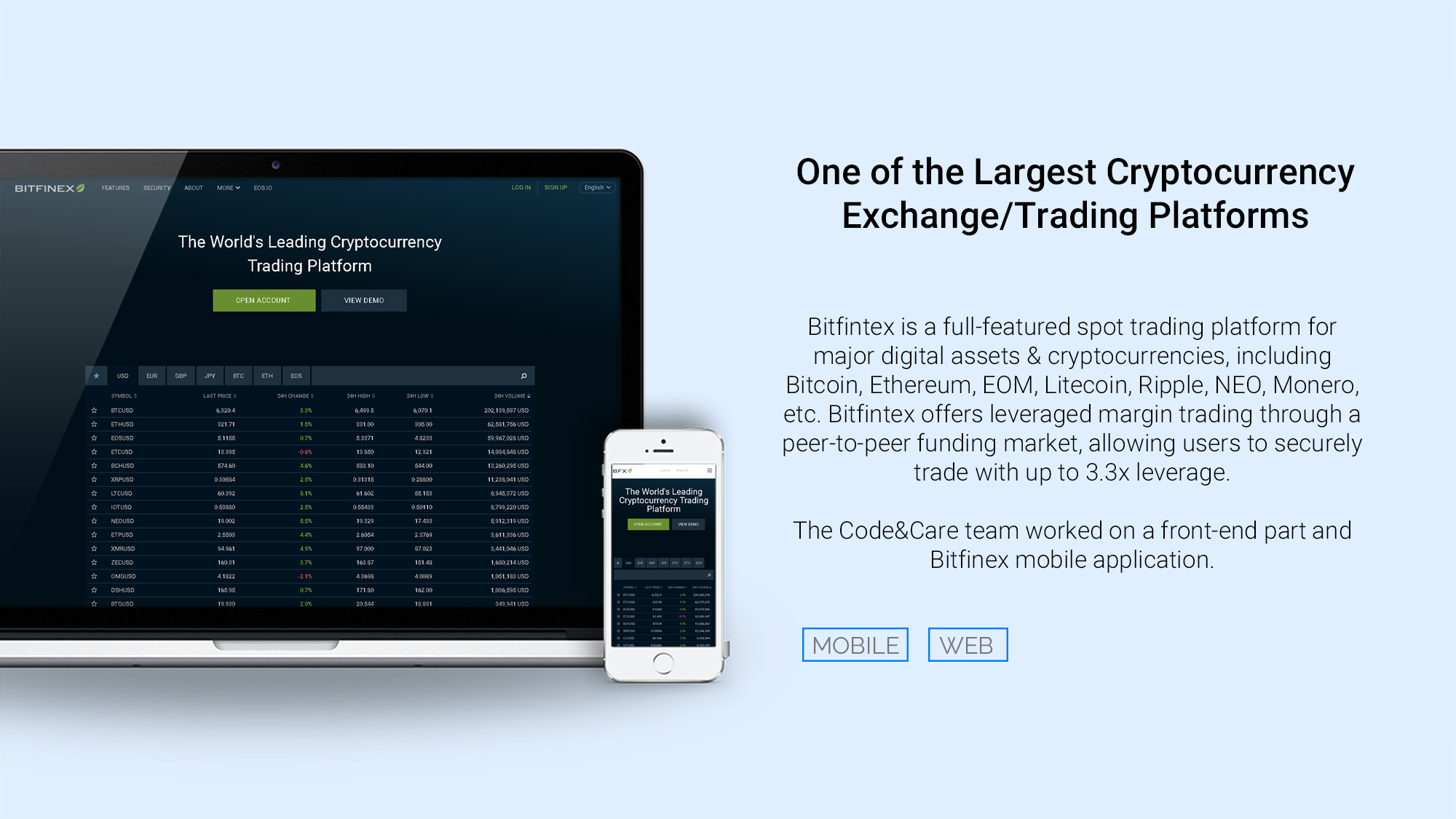
Conclusion
Summing up, blockchain technology is gaining popularity due to the benefits they provide. Companies are becoming more flexible by integrating a payment method that operates 24/7 365 days per year, performs cross-border transactions with lower fees, builds a customer base worldwide and provides freedom and safety. There is a growing demand for blockchain and bitcoin-based services right now.
If you are looking for a company to develop an application for any purpose, do not hesitate to contact Code&Care and learn more about our experience. Our team has significant experience in creating mobile and cross-platform applications.

How to Make an App Like OnlyFans: Features, Steps, Cost
Benefits of Blockchain in Insurance: Use Cases and Main Features
How to Make an App like Clubhouse: Features, Tech Stack, Cost
How to Create a Fitness App: All You Need to Know

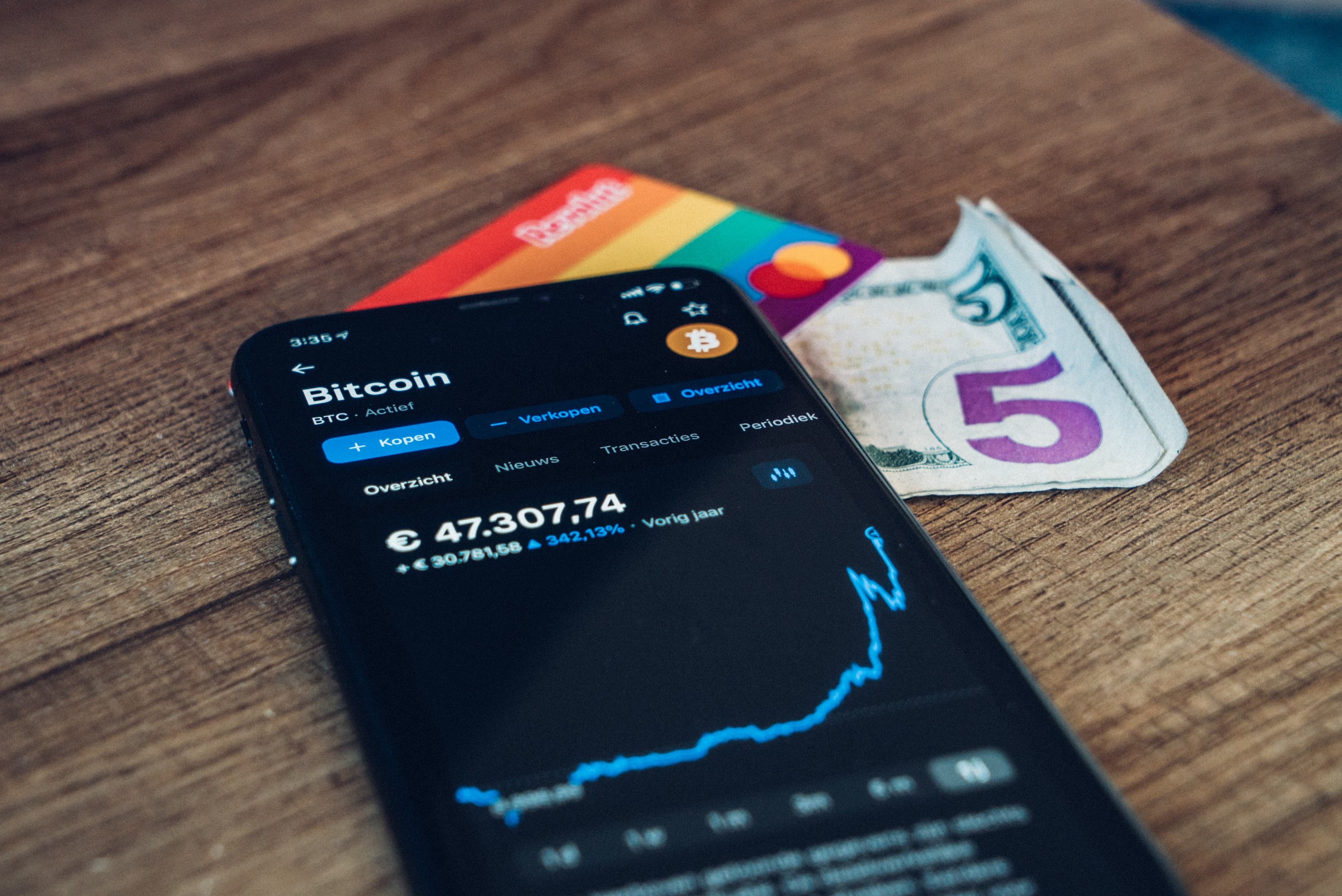














Popular
Latest